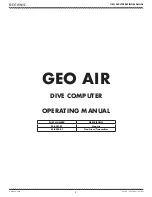
6-12 Programming the RGA Head
SRS Residual Gas Analyzer
Programming the RGA Head
This section describes the basic programming steps needed to configure, operate, and
diagnose the RGA. The emphasis is on general program implementation without going
into specific details on the different commands that are mentioned.
Please consult the “RGA Command Set” section of this chapter to get more detailed
information on the RGA commands and their implementation.
Initializing the RGA Head
The RGA Head is ready to communicate a few seconds after it is turned on and all the
built-in internal checking is performed. The
Initialization
commands are commonly used
to test the quality of the RS232 interface, to reset the RGA’s communication buffers, to
scan the hardware for problems, and to reset the unit to its default (factory preferred)
parameter settings.
Initializing the RGA communications
The two commands most often used after connecting to the head are:
ID?
Identification Query. Echoes the RGA’s ID string.
IN0
Clear communication buffers. Echoes the STATUS Byte.
The ID? command is used to test the RS232 interface: The ID String, stored in the RGA
Head, is returned to the computer and the integrity of the RS232 link is assured once the
character string is received. The ID string also contains useful information such as model
and serial number of the RGA head.
The IN0 command clears all the RGA’s RS232 buffers, runs a fresh set of tests on the
ECU’s hardware and sends back the STATUS Byte. Check the value of the STATUS
byte for potential errors.
Programming tips
x
Use the IN0 command every time there seems to be problems with the RS232
communications. The following procedure is recommended in those cases:
1. Reset the buffers in the computer.
2. Send a few carriage returns to clear the RGA’s receive buffer.
3. Send the IN0 command to reinitialize the RGA’s buffers.
4. Wait for the STATUS error byte to come back.
5. Test STATUS for possible errors.
This trick is very useful to reset communications on both ends and is often
implemented as a menu item.
x
The ID? command is used for a variety of purposes:
-Make sure the RGA is powered up and ready to go.
-Check the quality of the serial connection to the host computer.
-Check the user’s communication software to make sure it is communicating properly
with the RGA.
-Check the serial numbers of the RGA heads connected to the computer's serial ports.
Summary of Contents for RGA100
Page 4: ...SRS Residual Gas Analyzer iv...
Page 18: ...xviii Command List SRS Residual Gas Analyzer...
Page 46: ...2 14 Residual Gas Analysis Basics SRS Residual Gas Analyzer...
Page 66: ......
Page 78: ...4 12 Mass Filter Power supply SRS Residual Gas Analyzer...
Page 104: ......
Page 107: ...Programming the RGA Head 6 3 SRS Residual Gas Analyzer Error Byte Definitions 6 69...
Page 216: ...8 26 Quadrupole filter cleaning SRS Residual Gas Analyzer...
Page 246: ...11 2 SRS Residual Gas Analyzer...
Page 247: ......
Page 248: ......
Page 268: ...Appendix B SRS Residual Gas Analyzer 7...
Page 312: ...Appendix D SRS Residual Gas Analyzer 27...
















































